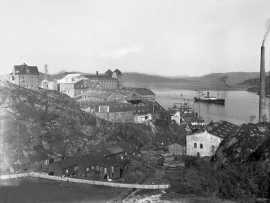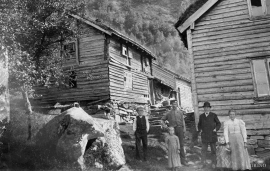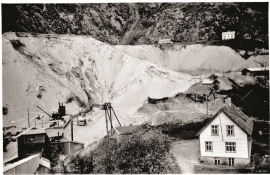- Remove Archaeology filter Archaeology
- Remove Livelihood and Craftsmanship filter Livelihood and Craftsmanship
- Remove Industry, Energy and Natural Resources filter Industry, Energy and Natural Resources
- Remove People and Society filter People and Society

Høybøen
In connection with the planned developments in the oil sector at Vindenes around 1980, excavations were carried out under the auspices of Bergen Historical Museum. Exceptionally interesting traces of an old farm at Høybøen then came to light. These were the remnants of a farm where there had been two houses containing several rooms.

Kinsarvik
Kinsarvik has probably been a centre for the inner Hardanger districts back in prehistory. History tells us that in medieval times there was a marketing place, a “kaupang”, here; a connecting point in the communications between east and west. There were supposedly around 300 residents here but the place was likely wiped out in a great fire.

Knarrevik
Having passed well over the bridge across to Sotra you pass an industrial plant surrounded by a budding community; the mineral mill of A/S Norwegian Talc. Some of the buildings seem to have been erected in the early part of the 20th century. They are remnants of a grand industrial plant from the former boom time in the country – the economic upswing after WWI.

Kvilekvål
The story of Knute Nelson is like the story of Jack the Dullard. From narrow and poor conditions in his home country he worked his way up to become governor and senator in the US.

Last Ice Age
The continental glacier that covered Hordaland was like a great power that had decisive influence over our natural history. The glaciers which at the beginning of the last ice age (more than 100,000 years ago) grew out from Folgefonna, Hardangerjøkulen and other mountainous areas, chased animals and birds, and most likely also humans in front of their paths. Small animals, plants and trees were mercilessly run over and crushed to powder under the thick ice. Even the hard bedrock got torn up and scoured by the ice, which did not give up before it reached the outer edges of the continental shelf. First 14,500 years ago, the climate became mild enough that the outer coastal strip of Hordaland once again became ice-free. Plants, animals and people started to migrate in to a landscape that was golden, with flecks of grey moraine and sand between smoothly polished rock outcrops - as our present warm interglacial was born.


Litlabø
The first finds of pyrite at Litlabø in Stord came to light in 1864. Forty years later sulphuric ore was mined from an open mine. From 1874 to 1880 it was used for dynamite production. That came to a sudden end when the factory exploded and three people died.


Lurekalven
Lurekalven is an unpopulated island of heather moor which is a part of the wilderness belonging to the five farms on Ytre Lygra. Between the two islands there is only a small sound. As late as the 1920s, milking cows were rowed over the sound from Lygra in summer – a form of farming that was adapted to the coastal landscape.


